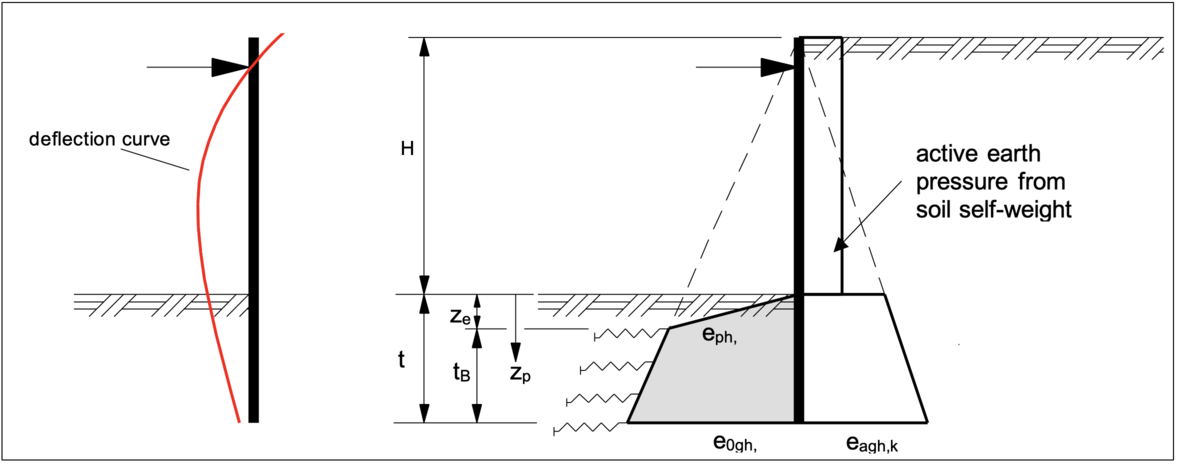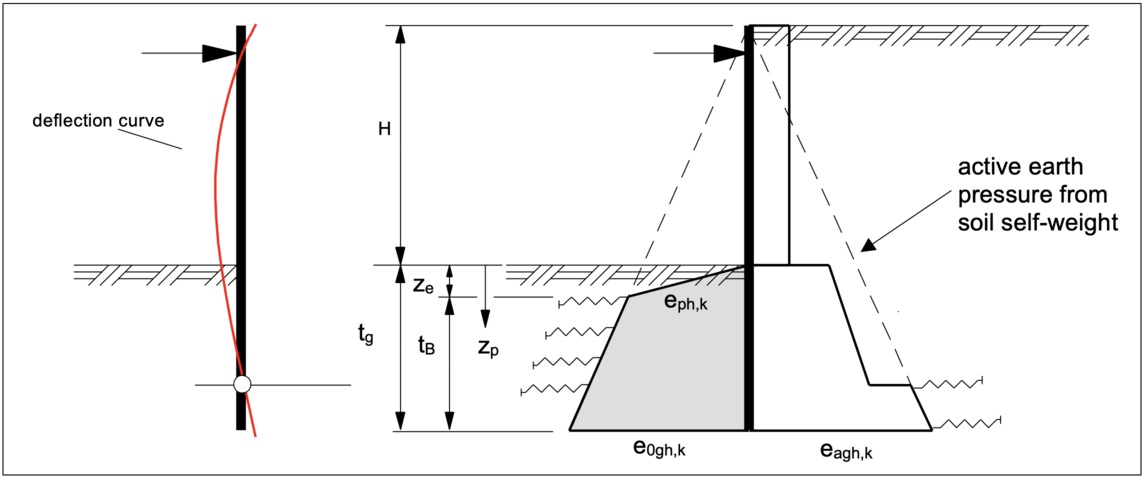Elastic earth support of retaining walls – modulus of subgrade reaction method
Table of contents
1. Elastic support of retaining walls – modulus of subgrade reaction method
According to DIN 1054 and EAB (“Empfehlungen des Arbeitskreises “Baugruben”), the verifications of the required embedment depth, the serviceability analyses and the determination of the internal forces or state variables can be carried out using the modulus of subgrade reaction method. According to the EAB, the wall-soil interaction, the actual structural behavior and the anticipated displacements and deformations can be taken into consideration more realistically than if a predetermined distribution of the soil reaction (with an assumed degree of fixity) and deflection of the wall toe are assumed. Following this approach, the modulus of subgrade reaction has to be determined realistically before the calculation.
Do you want to get started directly with the design of retaining walls? Just one "mouse click" will take you to the license variants of the software solution: GGU-RETAIN.
2. Calculation approach, verifications
According to DIN 1054, a deformation-dependent soil reaction may be applied at the toe of a retaining wall. The modulus of subgrade reaction method is used for this purpose. The soil reaction σh,k results from the horizontal wall displacement sh and the characteristic value of the modulus of subgrade reaction ks,k in
σh,k = ks,k • sh
The characteristic stress σh,k from the deformation-dependent lateral soil reaction must not exceed the maximum possible earth resistance resulting from the characteristic passive earth pressure eph,k:
σh,k ≤ eph,k
According to EAB, EB 102, it may be assumed in approximation that the original at-rest earth pressure on the excavation side of the wall remains generally unaffected even after the excavation is complete. This implies that the at-rest earth pressure is “conserved” during excavation. The initial stress from the bottom of the excavation pit thereby is limited to the passive earth pressure. Only from depth ze an elastic ground reaction may be adopted as s function of the local displacement sh as a subgrade reaction.
Only the ground reaction - below the intersection of the earth pressure as at-rest e0g,k and the passive earth pressure eph,k - exceeding the at-rest earth pressure may be taken as the subgrade reaction as a function of the displacement of the retaining wall. The following figure shows the development of the at-rest earth pressure, the earth resistance and the active earth pressure (here only for permanent actions from soil self-weight).

In the case of large embedment depths and retaining walls that are easy to deform, the retaining wall may develop reverse deformations below a low-lying pivot point that are directed towards the earth side. Thus it seems reasonable to apply the subgrade reaction only above this pivot point (zero displacement point) and to apply the at-rest earth pressure below the zero displacement point on the earth side.
Do you want to get started directly with the design of retaining walls? Just one "mouse click" will take you to the license variants of the software solution: GGU-RETAIN.

It must be verified that the subgrade reaction Bh,k below the intersection of the at-rest earth pressure and earth resistance must not exceed the passive earth pressure eph,k.
The sum of the at-rest earth pressure e0gh,k and the subgrade reaction Bh,k must therefore be less than the passive earth pressure eph,k to meet the following requirement:
e0gh,k + σBh,k ≤ eph,k
3. Modulus of subgrade reaction
According to EAB, EB 102, the modulus of subgrade reaction ksh,k may be derived approximately from the constrained modulus ESh,k where tB is the statically required embedment depth.
For cast-in-place concrete walls and sheet pile walls, the following applies approximately:
ksh,k = ESh,k / tB
For soldier piles walls, the following applies in accordance with DIN 1054 with the soldier piles’ flange width b:
ksh,k = ESh,k / b
Due to the nonlinear relationship between the stress level and the magnitude of the constrained modulus ESh,k, the latter must be determined for the expected stress level. If the constrained modulus is only known in the vertical direction it must be converted, in approximation, to a horizontal direction using a factor 0,5 ≤ f ≤ 1,0.
Table EB 102-1 gives reference values for average moduli of subgrade reaction for continuous walls in non-cohesive soils below the groundwater table for a passive earth pressure utilization factor μ ≈ 1,0 in the DS-T design situation:

For non-cohesive soils above the groundwater level, the above values may be doubled. For stiff to semi-solid cohesive soils, subgrade reaction moduli between 3 and 9 MN/m² may be applied.
4. Example of the use of the computer program GGU-RETAIN for the modulus of subgrade reaction method (incl. video)
The following video shows how the necessary verifications for the design situation DS-P for a sheet pile wall with an elastic support and with a single anchor can be performed using the computer program GGU-RETAIN:
Notes on use
All texts, images and media listed here are subject to copyright and are the intellectual property of Civilserve GmbH. Use is only permitted with appropriate reference and a link to this source.